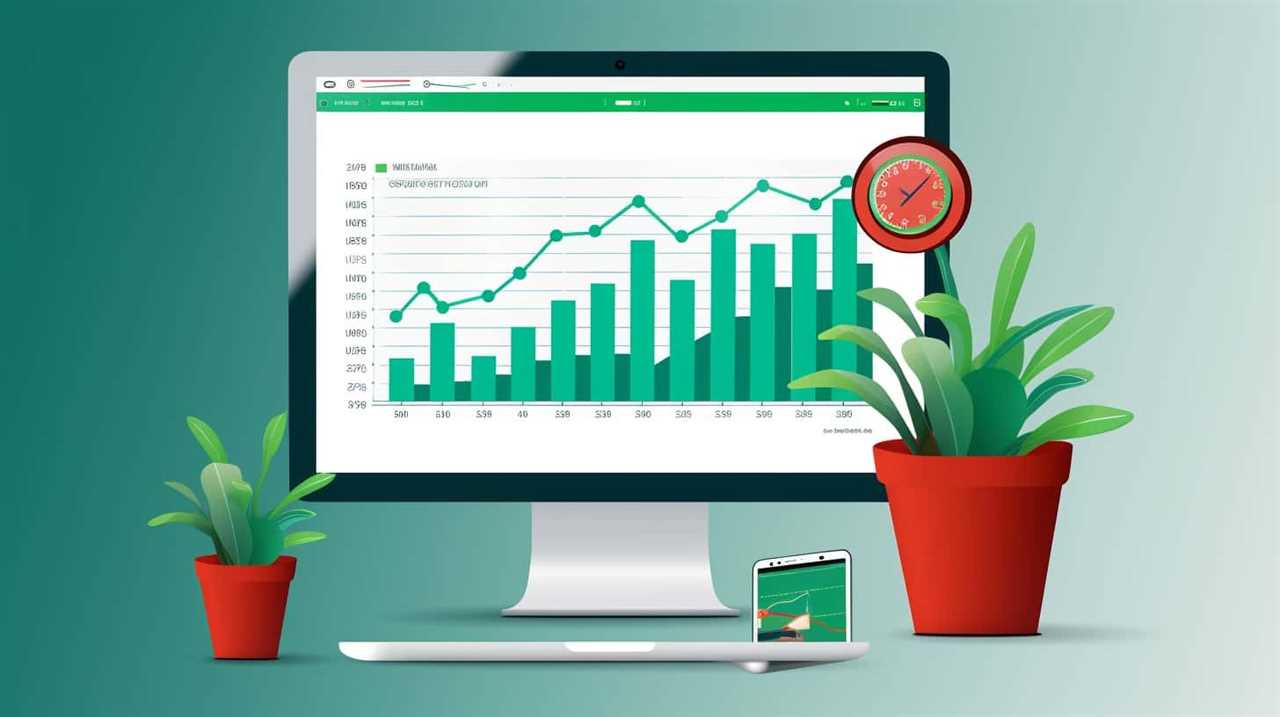Subjects to talk about:
- Utilizing Google Ads to drive online sales for custom bike products.
- Incorporating location extensions in Google Ads to promote in store visits to the bike shop
As an avid cyclist and owner of a custom bike shop, I know the importance of staying ahead in the digital age. That’s why I turned to Google Ads to rev up my online presence and drive more traffic to my business.
In this article, I’ll share the strategies and insights I’ve gained along the way, helping you gear up for digital success. From targeting your ideal audience to optimizing keywords and analyzing ad performance, get ready to pedal towards growth with Google Ads.
Key Takeaways
- Utilizing Google Ads can drive traffic and boost sales for custom bike shops.
- Targeting the ideal audience through demographic and behavioral segmentation is crucial for maximizing reach.
- Crafting engaging ad copy with compelling headlines and emotional appeals can capture attention and drive more traffic.
- Monitoring ad performance, tracking metrics like CTR and conversion rates, and optimizing campaign efforts are essential for digital success.
Understanding the Power of Google Ads
I’ve realized the immense potential of Google Ads in driving traffic and boosting sales for custom bike shops. As a marketing professional in the cycling industry, I understand the importance of utilizing digital advertising platforms to reach a wider audience. Google Ads, in particular, offers a plethora of tools and features that can help custom bike shops thrive in the online marketplace.

One key aspect of Google Ads that custom bike shop owners should focus on is measuring the return on investment (ROI) of their campaigns. By analyzing data such as clicks, conversions, and revenue generated, shop owners can determine the effectiveness of their advertising efforts. This allows them to make informed decisions and allocate their budget towards the most successful campaigns.
Another crucial factor in achieving Google Ads success is implementing effective bidding strategies. Custom bike shops can maximize their visibility by strategically bidding on relevant keywords and adjusting their bids based on performance. By monitoring and optimizing their bids, shop owners can ensure that their ads appear in prime positions on Google search results, ultimately driving more traffic to their website.
Setting Up Your Google Ads Account
To successfully harness the power of Google Ads, custom bike shop owners must begin by setting up their Google Ads account. This process is crucial as it lays the foundation for your advertising campaigns and ensures that your ads reach the right audience. Setting up your Google Ads account involves a few key steps.
First, you’ll need to sign up for a Google Ads account by visiting the Google Ads website. Once you’ve created your account, you can start by setting your advertising goals and budget. This will help you determine how much you’re willing to spend on your campaigns and what you hope to achieve with your ads.

Next, you’ll want to optimize your ad campaigns by selecting the right keywords and writing compelling ad copy. Keywords are the words or phrases that people search for when looking for products or services like yours. By targeting the right keywords, you can ensure that your ads appear in relevant search results and attract potential customers.
Additionally, you’ll want to choose the right ad format for your campaigns. Google Ads offers a variety of ad formats, including text ads, display ads, and video ads. Depending on your goals and target audience, you can choose the format that best suits your needs.
Targeting Your Ideal Audience
When it comes to targeting your ideal audience for your custom bike shop, there are a few key strategies to consider.
First, demographic targeting allows you to reach people based on their age, gender, and interests, ensuring you’re reaching those most likely to be interested in your products.

Second, behavioral audience segmentation allows you to target individuals based on their online behaviors, such as their browsing history or previous purchases, increasing the chances of conversion.
Lastly, location-based ad targeting allows you to focus your ads on specific geographic areas, ensuring you’re reaching potential customers in your local area.
Demographic Targeting Strategies
My custom bike shop’s demographic targeting strategy focuses on identifying and reaching our ideal audience. We understand the importance of personalized advertising and niche market segmentation to effectively connect with potential customers. By tailoring our marketing efforts to specific demographics, we can maximize our reach and increase the chances of conversion.
To achieve this, we have conducted extensive research and analysis to identify key characteristics and preferences of our target audience. This information allows us to create targeted advertisements that resonate with our ideal customers.

Here is a breakdown of our demographic targeting strategy:
| Demographic | Targeting Approach |
|---|---|
| Age | 25-45 years old |
| Gender | Male and Female |
| Location | Urban areas |
| Interests | Outdoor activities |
| Income | Middle to high |
Behavioral Audience Segmentation
As I delve into the topic of behavioral audience segmentation, I continue to build upon our demographic targeting strategy to effectively reach and engage our ideal customers. In this phase, we go beyond basic demographics and focus on targeting psychographic interests.
By understanding the behaviors, interests, and preferences of our audience, we can customize our ad messaging to resonate with niche audiences.
Targeting psychographic interests allows us to tap into the motivations and desires of our potential customers, ensuring that our ads are relevant and compelling. Whether someone is a hardcore mountain biker or a casual city cyclist, we can tailor our message to speak directly to their needs and interests.

Customizing ad messaging for niche audiences not only increases the likelihood of capturing their attention but also improves the chances of converting them into loyal customers. By addressing their specific pain points and showcasing how our custom bikes can enhance their riding experience, we create a stronger connection with our target audience.
Now that we’ve explored behavioral audience segmentation, let’s move on to the next section where we’ll discuss location-based ad targeting.
Location-Based Ad Targeting
To effectively target our ideal audience, we can utilize location-based ad targeting through Google Ads. This powerful tool allows us to reach potential customers who are in close proximity to our custom bike shop.
By implementing geo fencing strategies, we can create virtual boundaries around specific areas and deliver targeted ads to individuals within those boundaries. This means that our ads will only be shown to people who are physically located near our shop, increasing the chances of attracting foot traffic and generating sales.

Additionally, utilizing local search campaigns can further enhance our location-based targeting. This feature allows us to optimize our ads for local searches, ensuring that our shop appears prominently when potential customers are searching for custom bikes in our area.
Creating Compelling Ad Copy
With a focus on driving results, I craft engaging ad copy that captures the attention of potential customers for custom bike shops. Ad copy optimization is essential in creating persuasive ads that effectively communicate the unique value proposition of a custom bike shop.
When writing ad copy, I prioritize clarity, conciseness, and precision. Every word counts in the limited space available, so it’s crucial to make every word impactful. I use compelling headlines that grab attention and make the reader want to learn more. I highlight the key benefits of custom bikes, such as superior performance, unique designs, and personalized fit.
To make the ads more persuasive, I employ emotional appeals that resonate with cyclists. I tap into their desire for adventure, freedom, and self-expression. By painting vivid pictures with words, I create a sense of longing and aspiration that motivates potential customers to take action.

Furthermore, I incorporate strong calls to action that prompt users to click on the ad and explore the custom bike shop’s offerings. Whether it’s ‘Shop Now,’ ‘Discover Your Perfect Ride,’ or ‘Get Your Dream Bike Today,’ I make the call to action compelling and urgent.
Optimizing Keywords for Bike Shop Success
How can I effectively optimize keywords for the success of a bike shop?
Keywords play a crucial role in driving targeted traffic to your bike shop’s website and increasing your visibility online. To optimize keywords for bike shop success, consider the following strategies:
- Focus on local SEO: Incorporate location-specific keywords to attract customers in your area. This will help your bike shop rank higher in local search results and attract customers who are more likely to visit your store.
- Leverage social media: Use relevant keywords in your social media posts to improve your bike shop’s visibility on platforms such as Facebook, Instagram, and Twitter. Engage with your audience, share product updates, and encourage user-generated content to increase brand awareness.
- Use long-tail keywords: Long-tail keywords are more specific and targeted, allowing you to reach customers who are actively searching for bike-related products or services. For example, instead of using the keyword ‘bikes,’ use ‘mountain bikes for sale in [your location].’
- Monitor and refine your keyword strategy: Regularly analyze the performance of your keywords and make necessary adjustments. Use tools like Google Analytics to track keyword rankings, click-through rates, and conversions to ensure you’re targeting the right keywords for your bike shop.
By optimizing keywords for your bike shop, you can improve your online visibility, attract more customers, and increase your chances of success in the digital landscape.

Now, let’s delve into the next topic: utilizing ad extensions for enhanced visibility.
Utilizing Ad Extensions for Enhanced Visibility
I frequently utilize ad extensions to enhance the visibility of my custom bike shop on Google Ads. Ad extensions are additional pieces of information that can be displayed with your ads, providing more context and enticing potential customers to click. By optimizing ad extensions, I’ve been able to increase click-through rates and drive more traffic to my website.
One of the most effective ad extensions I use is the Sitelink extension. This allows me to showcase specific pages on my website, such as ‘Mountain Bikes’, ‘Road Bikes’, and ‘Custom Bike Builder’. By providing these direct links, customers can easily navigate to the pages that interest them the most, increasing the likelihood of conversion.
Another valuable ad extension is the Call extension. This allows potential customers to call my shop directly from the ad, making it convenient for them to inquire about products or schedule appointments.

Additionally, I make use of the Structured Snippet extension to highlight key features of my bikes, such as ‘Lightweight Frames’, ‘Premium Components’, and ‘Custom Paint Jobs’. This helps to differentiate my shop from competitors and showcase the unique selling points of my products.
Monitoring and Analyzing Ad Performance
To effectively gauge the success of my Google Ads campaigns for my custom bike shop, I closely monitor and analyze the performance of my ads. This allows me to make informed decisions and optimize my advertising efforts for maximum impact.
Here are four key aspects of ad performance that I focus on:
- Click Through Rates (CTR): I pay close attention to the CTR of my ads, as it indicates the percentage of people who click on my ads after seeing them. A higher CTR suggests that my ads are relevant and compelling to my target audience.
- Conversion Rates: Monitoring the conversion rates helps me understand how many people are taking the desired action on my website, such as making a purchase or filling out a contact form. By analyzing this data, I can identify areas for improvement and optimize my campaigns accordingly.
- Return on Ad Spend (ROAS): ROAS is a crucial metric for me as it shows the revenue generated for every dollar spent on advertising. By tracking this metric, I can determine which campaigns are providing the highest return on investment and allocate my ad budget accordingly.
- Ad Budget Allocation: Regularly reviewing my ad budget allocation allows me to assess the effectiveness of each campaign and make data-driven decisions. I can reallocate funds from underperforming campaigns to those that are yielding better results.
A/B Testing for Maximum Results
By implementing A/B testing, I can further optimize my Google Ads campaigns for maximum results and continue to improve the effectiveness of my advertising efforts. A/B testing, also known as split testing, is a powerful technique that allows me to compare two versions of an ad and determine which one performs better. It helps me make data-driven decisions and refine my advertising strategies.

To conduct A/B testing, I start by creating two variations of my ad, with only one element being different between them. It could be the headline, the image, the call-to-action, or any other component. I then run both versions simultaneously and measure their performance using key metrics like click-through rate (CTR), conversion rate, and cost per acquisition (CPA).
To ensure accurate results, it’s essential to follow A/B testing best practices. I make sure to test only one element at a time to accurately attribute any changes in performance. I also ensure that the sample size is statistically significant to draw reliable conclusions. Additionally, I run the test for a sufficient duration to account for any fluctuations in performance.
Measuring ad effectiveness through A/B testing allows me to understand what resonates with my target audience and optimize my campaigns accordingly. It helps me identify areas of improvement and make data-backed decisions to achieve better results.
As I continue to refine my ads through A/B testing and measure their effectiveness, I can now focus on scaling my Google Ads campaign for growth.

Scaling Your Google Ads Campaign for Growth
When it comes to scaling your Google Ads campaign for growth, there are a few key points to consider.
First, it’s important to allocate your budget optimally, ensuring that you’re investing in the right areas for maximum impact.
Secondly, targeting relevant keywords is crucial, as this will help you reach your desired audience and increase the chances of conversions.
Lastly, tracking conversion rates is essential for measuring the success of your campaign and making any necessary adjustments along the way.

Optimal Budget Allocation
In my experience, a well-planned and executed budget allocation is essential for scaling your Google Ads campaign for growth as a custom bike shop. To achieve optimal results, consider the following strategies:
- Budget optimization: Regularly review and adjust your budget allocation based on the performance of your ads. Allocate more budget to campaigns that generate higher conversion rates and lower cost per acquisition.
- Ad spend analysis: Analyze the effectiveness of your ad spend by tracking key metrics such as click-through rates, conversion rates, and return on ad spend. Use this data to identify underperforming campaigns and reallocate your budget accordingly.
- Test and iterate: Experiment with different budget allocations to find the optimal balance between maximizing reach and maintaining a profitable return on investment. Continuously monitor and adjust your budget allocation based on the performance of your ads.
- Consider seasonality: Take into account seasonal trends and fluctuations in demand when allocating your budget. Increase your ad spend during peak periods to capture a larger share of the market.
Targeting Relevant Keywords
To achieve growth in my Google Ads campaign for my custom bike shop, I need to target relevant keywords using a compound preposition.
One effective strategy is long tail keyword optimization. Instead of focusing on broad keywords like ‘bikes’ or ‘custom bikes,’ I can target more specific phrases such as ‘custom mountain bikes for sale’ or ‘handmade road bikes in [city].’ These long tail keywords attract a more qualified audience who are actively looking for the specific products or services I offer.
Additionally, I can make use of negative keyword targeting to exclude irrelevant searches. By identifying and excluding keywords like ‘cheap’ or ‘used,’ I can ensure that my ads are only shown to users who are more likely to convert into customers.

Tracking Conversion Rates
To effectively scale my Google Ads campaign for growth, I track conversion rates using a compound noun. By closely monitoring these rates, I can make data-driven decisions to improve the effectiveness of my ads and drive more conversions.
Here are a few strategies I employ to optimize my campaign:
- Improving landing page design: I continuously analyze and optimize my landing pages to ensure they’re engaging, user-friendly, and aligned with my ad messaging. This helps to increase conversions and improve the overall user experience.
- Ad scheduling optimization: I closely examine the performance of my ads during different times of the day and week. By identifying peak times of engagement, I can strategically schedule my ads to maximize visibility and increase conversions.
- Utilizing conversion tracking tools: I leverage the power of conversion tracking tools provided by Google Ads to accurately measure the success of my campaigns. These tools allow me to track important metrics such as click-through rates, conversion rates, and cost per conversion.
- A/B testing: I constantly test different variations of my ads to identify the most effective messaging, design, and call-to-action. This helps me to refine my ads and increase their conversion rates.
Frequently Asked Questions
How Much Does It Cost to Set up a Google Ads Account for a Custom Bike Shop?
Factors to consider when budgeting for a Google Ads campaign for a custom bike shop include keyword competition, target audience, and campaign goals. Avoid common mistakes like neglecting to optimize landing pages and not tracking conversions properly.
Can Google Ads Help Increase Foot Traffic to My Physical Bike Shop Location?
Increasing foot traffic to a physical bike shop location can be achieved through various strategies. One effective method is using Google Ads to target potential customers in the local area, driving them to visit the shop and explore its offerings.

Are There Any Specific Strategies for Targeting a Niche Audience Within the Custom Bike Industry?
There are several effective ad copy techniques that can be used to target a niche audience within the custom bike industry. By understanding their specific needs and preferences, we can create compelling ads that resonate with them and drive more conversions.
How Can I Ensure That My Ad Copy Stands Out From Competitors in the Market?
To ensure my ad copy stands out, I create compelling content that sets my custom bike shop apart from competitors. I maximize click through rates, optimize landing pages for conversions, and utilize ad extensions effectively.
Are There Any Limitations to the Number of Keywords I Can Optimize for in My Google Ads Campaign for a Bike Shop?
There are limitations to the number of keywords I can optimize for in my Google Ads campaign for a bike shop. To choose the most effective ones, I need to consider relevance and competition.
Conclusion
In conclusion, Google Ads can be a game-changer for custom bike shops looking to achieve digital success. By targeting the right audience, creating compelling ad copy, and optimizing keywords, bike shops can increase their visibility and drive more traffic to their website.

One interesting statistic to note is that businesses using Google Ads see an average conversion rate increase of 50%.
So why wait? Gear up your bike shop for success with Google Ads today!










